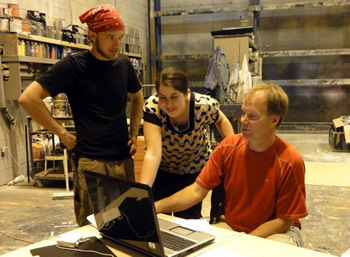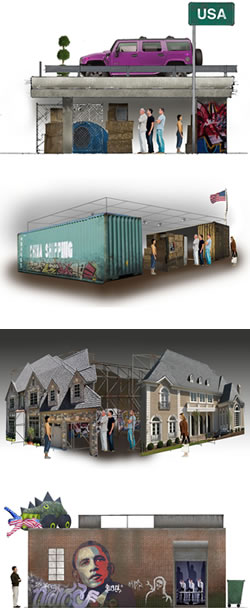News & Notices
PQ 2011 Exhibit Design Finalized

Michael Monsos works with Montana students Doug Dion and Johanna Josephian during a meeting of the USITT PQ USA ’11 team in August.
Photo/Sandy Bonds
The design for the exhibit structure and display of the USITT Prague Quadrennial USA 2010 entry went hand-in-hand with the curatorial process of considering what work would be featured. Artistic Director Susan Tsu and the curators of the team settled on a theme for the exhibit early on deciding to emphasize new performance work, especially work that was self-reflective and political in nature, or which examined issues preoccupying Americans today. The work of younger ensembles taking design and performance into the future was carefully considered as well as the courageous leading edge of signature founders.

Designs/William Bloodgood
The theme, From the Edge, led to much discussion of just what exactly the edge is and where it is to be found. Interestingly, once the 360 entries were narrowed down to the 36 that will represent the USA, it was clear that the Edge became defined not only as the brave and dangerous edge of creation but as our country on edge.
William Bloodgood’s earliest conceptual thinking followed the curators’ evolving considerations including their discussion of social inequalities of American society, inadequacies of American government, and the selection of work that focused on the unconventional and anti-bourgeois. An early design proposed a literal chunk of an American highway overpass with a large SUV above and exhibit items housed in boxes and tents below. He based a second concept on setting the exhibit in a shanty-town arrangement of shipping containers and make-shift shacks. His third approach followed the curators’ consideration of the submitted work as a contrast to middle class American taste and sensibility – an arrangement of false-front American suburban “McMansions” would surround a rough interior for the actual exhibit.
Much of the work chosen is ensemble-generated, and the design elements are less refined with sound, light, and multi-media projections frequently integral to the presence of the performers. Mr. Bloodgood finally found inspiration in the example of the Performing Garage in New York, a well known space that has served as the base and informed the work of the Wooster Group and in the workspaces of like companies.
The final suggests a well-used old garage space in a less-than-elegant section of a city. It is emblematic of the workspaces and performing venues of small groups of theatre artists working on the edge of a new aesthetic and without the resources typical of more established groups. The details and finish of the space will be realistic: brick walls, concrete floor, metal trusses, and industrial lighting above with ample evidence of the past lives of the building apparent. The display of models and two-dimensional pieces, arranged as an impromptu gallery with pedestals and tables made of industrial materials and recycled plywood, will be complemented by projected images on the upper sections of the interior walls. The space also will serve as a performance venue for artists Paul Zaloom and Pat Oleszko. Ms. Oleszko’s inflatable sculpture “Warosuarus” will be displayed on the roof of the exhibit structure as a prominent emblem of the U.S. presence at the exposition.
Seek USITT/USA PQ 2015 Manager
USITT’s International Committee seeks a volunteer exhibit projects manager for the USITT Prague Quadrennial USA 2015 performance design and space. This is a unique opportunity to involve students and universities in an internationally acclaimed theatre event. The person in this position serves as the technical director for constructing the three displays sponsored by USITT to represent American theatre design in the National, Student, and Architecture Exhibits at PQ and beyond. The volunteer taking on this position has usually been connected with a university or college theatre department with enough time, space, and labor to build the exhibits. Construction would take place between summer 2014 and spring 2015. USITT provides travel and housing support for two faculty and four student volunteers from the host school. As the 2011 exhibits are now underway, the 2015 exhibits projects manager would have the opportunity to join the process and observe the procedures firsthand. Click here for an application or contact Alexandra Bonds at abonds@uoregon.edu for further details.


